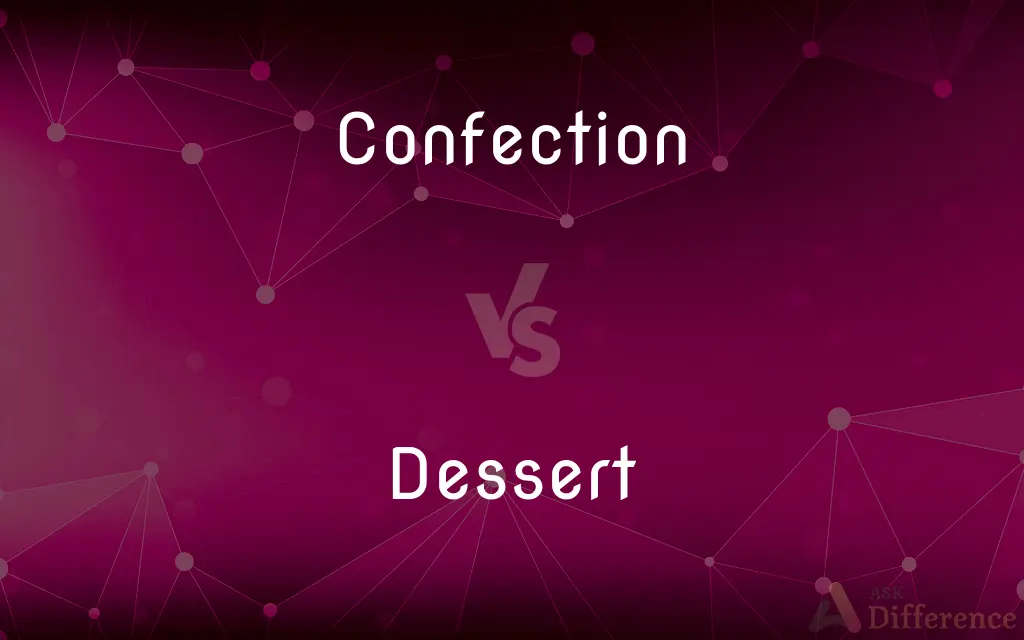Confection vs. Dessert — What's the Difference?
Edited by Tayyaba Rehman — By Urooj Arif — Updated on April 24, 2024
Confections are typically sweet treats often involving sugar processing, like candies and chocolates, whereas desserts are broader, encompassing any sweet course usually served after a meal.

Difference Between Confection and Dessert
Table of Contents
ADVERTISEMENT
Key Differences
Confections, such as candies or chocolate, are primarily sugar-based and often consumed as snacks. On the other hand, desserts are typically served at the end of meals and can include cakes, pies, and ice cream.
Confections are usually smaller and more focused on delivering intense sweetness, often without fruits or natural flavors. Whereas desserts may incorporate fruits, creams, and other ingredients to offer a variety of textures and flavors.
The preparation of confections often involves precise techniques like tempering chocolate or boiling sugar, whereas dessert preparation can range from baking a cake to assembling simple fruits with cream.
Confections are generally designed for individual consumption and easy portability, such as lollipops or gummi bears. On the other hand, desserts are often plated and presented in a way that complements the dining experience.
The shelf life of confections can be quite long due to high sugar content which acts as a preservative. Whereas desserts, particularly those containing dairy or fresh ingredients, typically have a shorter shelf life and need to be consumed sooner.
ADVERTISEMENT
Comparison Chart
Primary Ingredients
Sugar, syrup, chocolate
Fruits, dairy, flour, sugar
Typical Serving Time
Anytime, often as snacks
Typically at the end of a meal
Preparation Techniques
Boiling, tempering, molding
Baking, freezing, setting
Consumption Size
Small, bite-sized
Can range from small to large portions
Examples
Candy bars, jelly beans, marzipan
Cakes, ice creams, pastries
Compare with Definitions
Confection
A sweet food made primarily of sugar and often combined with chocolate or fruits.
Marshmallows are a popular confection used in s'mores.
Dessert
Any treat or dish served primarily to satisfy the sweet tooth.
Chocolate mousse is a rich dessert loved for its creamy texture.
Confection
A non-baked sweet treat, often involving nuts and caramel.
Toffee is a chewy confection made with butter and sugar.
Dessert
The sweet course eaten at the end of a meal.
Apple pie is a classic dessert in American cuisine.
Confection
Small, decorative candies often used for celebrations.
Jordan almonds are a traditional confection given at weddings.
Dessert
A dish often involving baking or freezing.
Cheesecake is a popular dessert that can be baked or set in a fridge.
Confection
Edible decorations made of sugar used to adorn desserts.
Sugar paste flowers are delicate confections used to decorate cakes.
Dessert
Often involves multiple ingredients like fruits, dairy, and flavors.
Fruit salad with whipped cream is a refreshing dessert.
Confection
A product resulting from the crystallization of sugar.
Rock candy is a confection made by allowing a supersaturated solution of sugar and water to crystallize.
Dessert
Can be a simple or elaborate preparation depending on the occasion.
A scoop of vanilla ice cream is a simple yet satisfying dessert.
Confection
The act or process of confecting or the result of it
"These sentiments are not the confection of a consummate courtroom actor" (Ron Rosenbaum).
Dessert
Dessert () is a course that concludes a meal. The course consists of sweet foods, such as confections, and possibly a beverage such as dessert wine and liqueur.
Confection
A sweet prepared food, such as candy or cake.
Dessert
A usually sweet course or dish, as of fruit, ice cream, or pastry, served at the end of a meal.
Confection
A sweetened medicinal compound; an electuary.
Dessert
Chiefly British Fresh fruit, nuts, or sweetmeats served after the sweet course of a dinner.
Confection
A piece displaying splendid craft, skill, and work
The gown was a confection of satin and appliqué.
Dessert
The last course of a meal, consisting of fruit, sweet confections etc.
I ordered hummus for a starter, a steak as the main course, and chocolate cake for dessert.
Can I see the dessert menu, please?
Confection
To make into a confection.
Dessert
A sweet dish or confection served as the last course of a meal.
Trifle is a favourite dessert of the English, but rivalled by pavlova in Australia and New Zealand.
Confection
A food item prepared very sweet, frequently decorated in fine detail, and often preserved with sugar, such as a candy, sweetmeat, fruit preserve, pastry, or cake.
The table was covered with all sorts of tempting confections.
Dessert
A service of pastry, fruits, or sweetmeats, at the close of a feast or entertainment; pastry, fruits, etc., forming the last course at dinner.
"An 't please your honor," quoth the peasant,"This same dessert is not so pleasant."
Confection
The act or process of confecting; the process of making, compounding, or preparing something.
Dessert
A dish served as the last course of a meal
Confection
The result of such a process; something made up or confected; a concoction.
The defense attorney maintained that the charges were a confection of the local police.
Confection
(dated) An artistic, musical, or literary work taken as frivolous, amusing, or contrived; a composition of a light nature.
Confection
(dated) Something, such as a garment or a decoration, that is very elaborate, delicate, or luxurious, usually also impractical or non-utilitarian.
Confection
(pharmacology) A preparation of medicine sweetened with sugar, honey, syrup, or the like; an electuary.
Confection
To make into a confection, prepare as a confection.
Confection
A composition of different materials.
A new confection of mold.
Confection
A preparation of fruits or roots, etc., with sugar; a sweetmeat.
Certain confections . . . are like to candied conserves, and are made of sugar and lemons.
Confection
A composition of drugs.
Confection
A soft solid made by incorporating a medicinal substance or substances with sugar, sirup, or honey.
Confection
A food rich in sugar
Confection
The act of creating something (a medicine or drink or soup etc.) by compounding or mixing a variety of components
Confection
Make into a confection;
This medicine is home-confected
Common Curiosities
What occasions are confections typically used for?
Confections are often used for gifting, as party favors, or as treats during festive occasions like Halloween or Easter.
Can desserts be savory?
While uncommon, some cultures do have savory desserts, incorporating elements like cheese or even meats, but these are exceptions in the broader context of typically sweet desserts.
How are desserts typically presented in a meal?
Desserts are usually presented as the final course in a meal, often plated elegantly to enhance the dining experience.
How do cultural differences influence what is considered a dessert or a confection?
Cultural preferences can define certain sweet dishes as desserts or confections differently; for instance, what is considered a dessert in one country could be a sweet snack (confection) in another.
Are all chocolates considered confections?
Yes, all types of chocolate treats are considered confections, although they can also play a role in desserts such as cakes and mousses.
What is the typical shelf life of confections compared to desserts?
Confections, due to their high sugar content, tend to have a longer shelf life than many desserts, especially those that include fresh dairy or fruit.
Do confections require refrigeration like some desserts?
Generally, confections do not require refrigeration unless they contain chocolate or cream fillings, whereas many desserts need to be kept cold.
How do preparation times for confections and desserts compare?
Confections can often be made quickly or in large batches and stored, while desserts may require more immediate preparation and serving.
Are there health considerations that differentiate confections from desserts?
Yes, confections often have higher sugar concentrations and fewer nutrients compared to desserts, which might incorporate fruits, nuts, and other nutritious ingredients.
What are some examples of confections that are commonly mistaken for desserts?
Items like caramel apples or chocolate-covered strawberries are confections that are often considered desserts due to their presentation and usage.
Can dietary restrictions affect whether a sweet treat is classified as a confection or dessert?
Dietary needs can influence the ingredients used but don't typically change the classification of a dish as either a confection or a dessert.
How are confections and desserts affected by seasonal variations?
Certain confections like peppermint candies are popular during specific holidays, while desserts can vary significantly by season, utilizing seasonal fruits and themes.
What is the role of confections in traditional desserts?
Confections like pralines or candied fruits often serve as components or decorations in more complex dessert dishes, enhancing both flavor and appearance.
What role do textures play in distinguishing between confections and desserts?
Confections often focus on a single texture, like the chewiness of caramel, while desserts can feature a complex interplay of textures, like the crunch of a crust with the softness of a filling.
Is the sugar content in confections always higher than in desserts?
Typically, yes, confections have a higher sugar content to ensure preservation and texture, while desserts might balance sweetness with other flavors and ingredients.
Share Your Discovery

Previous Comparison
Authentication vs. Certification
Next Comparison
Indoor vs. IndoorsAuthor Spotlight
Written by
Urooj ArifUrooj is a skilled content writer at Ask Difference, known for her exceptional ability to simplify complex topics into engaging and informative content. With a passion for research and a flair for clear, concise writing, she consistently delivers articles that resonate with our diverse audience.
Edited by
Tayyaba RehmanTayyaba Rehman is a distinguished writer, currently serving as a primary contributor to askdifference.com. As a researcher in semantics and etymology, Tayyaba's passion for the complexity of languages and their distinctions has found a perfect home on the platform. Tayyaba delves into the intricacies of language, distinguishing between commonly confused words and phrases, thereby providing clarity for readers worldwide.
















































